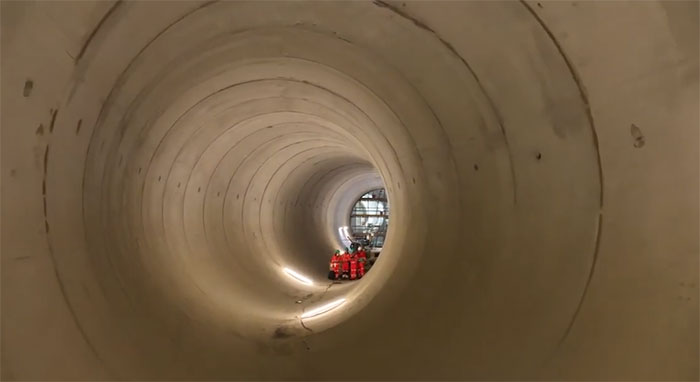Huge sewer pipes underneath London
A massive concrete pipeline with a capacity of 1.6 million cubic meters is being built under London to reduce the frequency of wastewater discharges into the River Thames .
London's new super sewer , a giant concrete pipe running 25km along the River Thames, is designed to solve a problem that the British capital and many other cities have struggled to cope with for decades: discharge of untreated wastewater into rivers, New Scientist reported on June 2.
London's current sewer system is cracking at many seams. That system was built around 1859 - 1875 after the "Great Rotten River" disaster of 1858. At that time, the city's population was about 3 million people. Engineer Joseph Bazalgette designed a sewer pipe that could handle wastewater from 4.5 million people and rainwater. Currently, about 9 million people are using the system. The weather is getting wetter and London is increasingly concreted, preventing the soil from absorbing rainwater.
The old system could not cope with the situation and was overloaded around 60 times a year, discharging a total of 50 million tonnes of raw sewage each year into the River Thames, alongside wet wipes, sanitary products, condoms and any other What flushes down the toilet?
"Our mission is to build a sewer line that solves that problem ," said Andy Mitchell, chief executive of Tideway, the company behind the project. Their solution was to build a giant pipe deep underground, beneath the Victorian sewer, to block the overflow. The Tideway Tunnel is one of the largest municipal sewer projects in the world, according to Mitchell. The project does not completely solve the problem, when the rain is really heavy, there is still sewage flowing into the river. But the project will reduce the frequency to about 3-4 times/year, and runoff water will mainly be rainwater.

The total capacity of the tunnel is 1.6 million m3.
The tunnel entrance is a concrete caldera the diameter of a cooling tower and 50 meters deep. It needs to be this big to be able to send massive tunneling machines down. The engineers were brought down gradually through a concrete frame attached to the crane. The circular tunnel has a diameter of 7.2 meters and took 8 years to build at a cost of 5.6 billion USD. The total capacity of the tunnel is 1.6 million m 3 . The project will go into operation next year.
The tunnel gradually slopes from west to east, allowing wastewater to flow by gravity without the need for pumping. When the wastewater reaches its destination at the Beckton treatment station, it is 80 meters underground and needs to be pumped up. In about a year, the tunnel will be completed. The lights will be removed, the entrance sealed and the tunnel will be in darkness for at least 120 years. Maintenance checks will be performed using drones.
- Video: The mountain of fat loosely over the blue whale sealed the London sewer
- The salamander 'fossil live' stuck two years in the sewer pipe
- He completed the 6.3 billion USD super sewer
- Explore the huge sewer system in Tokyo
- 'Endoscopy' with underground plastic equipment
- Robots detect failures in sewers
- Roman sluice can still be used after 2,300 years
- Utilize waste cooking oil to produce electricity
- Fashionable cars run by garbage
- The new initiative restores old iron and steel pipes
- 200-year-old Tasmanian tiger-shaped smoking pipe
- Australia's simple waste treatment is both effective and economical
 Norway built the world's tallest wooden tower
Norway built the world's tallest wooden tower Kremlin
Kremlin Ashurbanipal: The oldest royal library in the world
Ashurbanipal: The oldest royal library in the world Decoding the thousand-year construction of Qin Shihuang shocked the world
Decoding the thousand-year construction of Qin Shihuang shocked the world China launches unprecedented technological 'monster', solving mega-project that both the US and Japan are stumped by
China launches unprecedented technological 'monster', solving mega-project that both the US and Japan are stumped by  China builds world's largest tunnel boring machine
China builds world's largest tunnel boring machine  How was the world's longest submerged tube tunnel built?
How was the world's longest submerged tube tunnel built?  California built a $20 billion rainwater storage tunnel
California built a $20 billion rainwater storage tunnel  The strongest wind tunnels in the world
The strongest wind tunnels in the world  Watch China build a 6-lane highway tunnel 70m deep at the bottom of the Yangtze River
Watch China build a 6-lane highway tunnel 70m deep at the bottom of the Yangtze River 